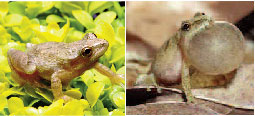SCORES & OUTDOORS: Those lovable little critters announcing spring’s arrival
 SCORES & OUTDOORS
SCORES & OUTDOORS
by Roland D. Hallee
Camp is open! Last Friday and Saturday my wife and I worked diligently to get things squared away at camp. Open the shelter, put away necessities for the summer, arrange outdoor furniture, check out the grill, etc. It was a busy two days, and Saturday night we finally sat down around the first campfire of the year.
Before I proceed, let me set the scene.
Next to our camp is a rather large gully that drains spring runoff from the top of the hill down to the lake. Just before you get to the pond, there is a large swampy area.
OK, got it? So there we are sitting around the campfire. At sunset came the sounds for which we have been waiting. The peepers. The unmistakable sound of spring. If you live east of the Mississippi River, you have definitely heard the sound of hundreds of chirping frogs.

A spring peeper, left, and one with its vocal sac inflated. Internet photos
While spring peepers are the most famous of all the frogs, they’re not the only species native to North America. Spring peepers, Pseudacris crucifer, exist in the eastern half of North America from Florida to Canada. You can distinguish the spring peepers, also known as chorus frogs, because their noise sounds very much like jingling bells when there are a lot of them around.
If you have ever seen a spring peeper, you have probably noticed a peculiar bubble that forms around the frog’s mouth. The bubble is actually the frog’s vocal sac. To make their calls, peepers close their nostrils and mouths and squeeze their lungs to inflate the sac. The peeping sound happens as air leaves the lungs, passes over the vocal chords and into the vocal sac.
The sounds they produce are mating calls emanating from the males, which are made from the edges of the bodies of water in which they breed. Even when calling, peepers may be difficult to locate. They typically breed from March to June when the warm rains start. The female will lay around 900 eggs, but up to 1,000 are possible. Egg clusters are hidden under vegetation, and they transform into frogs about eight weeks following the hatching.
Their environment includes marshy areas, especially wooded wetlands and swampy areas near forested areas because they like to hibernate under tree bark or fallen logs. Thus, the perfect habitat is what I described earlier.
They are an extremely small frogs, reaching a maximum size of about 1-1/2 inches and weigh about 0.18 ounces. Because of their diminutive size, they feed on small bugs like ants, small beetles, flies and spiders. They have large toe pads for climbing, although they generally spend their time amid loose debris.
Spring peepers are nocturnal and do most of their hunting at night.
Peepers, are among the first frogs in the region to call in the spring, and will make their first appearance shortly after ice goes out on the wetlands.
How to identify a peeper? That’s easy. They are tan or brown in color with a dark X-shaped marking across their back. Now, go out and try to find one.
The spring peeper has no special endangered status in most areas. They are common and widespread over the region. However, their habitats are quickly changing due to loss of wetlands. In some areas, their populations have decreased significantly. Where have we heard that before?
If you get the chance, spend an evening outside listening to the sounds of spring, and among them you will hear the chirps of these amazing little frogs.
Responsible journalism is hard work!
It is also expensive!
If you enjoy reading The Town Line and the good news we bring you each week, would you consider a donation to help us continue the work we’re doing?
The Town Line is a 501(c)(3) nonprofit private foundation, and all donations are tax deductible under the Internal Revenue Service code.
To help, please visit our online donation page or mail a check payable to The Town Line, PO Box 89, South China, ME 04358. Your contribution is appreciated!


Leave a Reply
Want to join the discussion?Feel free to contribute!